Boris Knyazev
Generating $π$-Functional Molecules Using STGG+ with Active Learning
Feb 20, 2025Abstract:Generating novel molecules with out-of-distribution properties is a major challenge in molecular discovery. While supervised learning methods generate high-quality molecules similar to those in a dataset, they struggle to generalize to out-of-distribution properties. Reinforcement learning can explore new chemical spaces but often conducts 'reward-hacking' and generates non-synthesizable molecules. In this work, we address this problem by integrating a state-of-the-art supervised learning method, STGG+, in an active learning loop. Our approach iteratively generates, evaluates, and fine-tunes STGG+ to continuously expand its knowledge. We denote this approach STGG+AL. We apply STGG+AL to the design of organic $\pi$-functional materials, specifically two challenging tasks: 1) generating highly absorptive molecules characterized by high oscillator strength and 2) designing absorptive molecules with reasonable oscillator strength in the near-infrared (NIR) range. The generated molecules are validated and rationalized in-silico with time-dependent density functional theory. Our results demonstrate that our method is highly effective in generating novel molecules with high oscillator strength, contrary to existing methods such as reinforcement learning (RL) methods. We open-source our active-learning code along with our Conjugated-xTB dataset containing 2.9 million $\pi$-conjugated molecules and the function for approximating the oscillator strength and absorption wavelength (based on sTDA-xTB).
Accelerating Training with Neuron Interaction and Nowcasting Networks
Sep 06, 2024



Abstract:Neural network training can be accelerated when a learnable update rule is used in lieu of classic adaptive optimizers (e.g. Adam). However, learnable update rules can be costly and unstable to train and use. A simpler recently proposed approach to accelerate training is to use Adam for most of the optimization steps and periodically, only every few steps, nowcast (predict future) parameters. We improve this approach by Neuron interaction and Nowcasting (NiNo) networks. NiNo leverages neuron connectivity and graph neural networks to more accurately nowcast parameters by learning in a supervised way from a set of training trajectories over multiple tasks. We show that in some networks, such as Transformers, neuron connectivity is non-trivial. By accurately modeling neuron connectivity, we allow NiNo to accelerate Adam training by up to 50\% in vision and language tasks.
Any-Property-Conditional Molecule Generation with Self-Criticism using Spanning Trees
Jul 12, 2024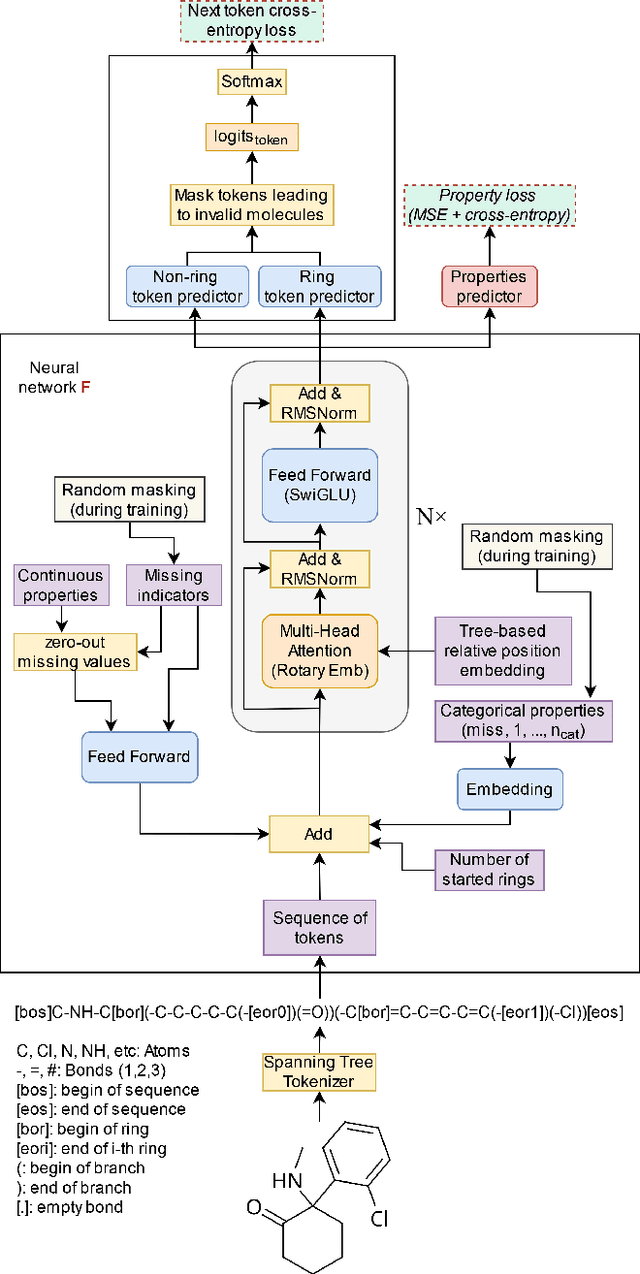
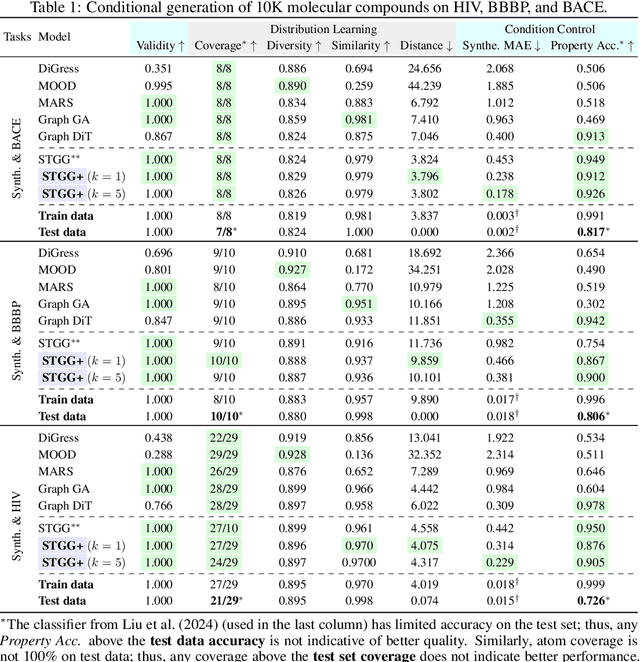
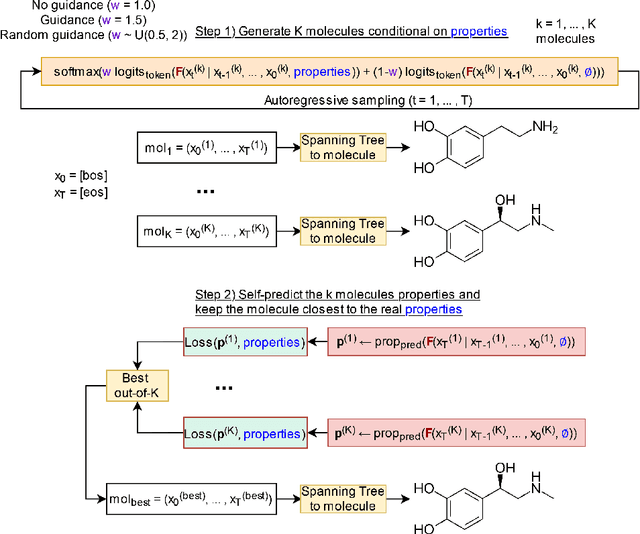
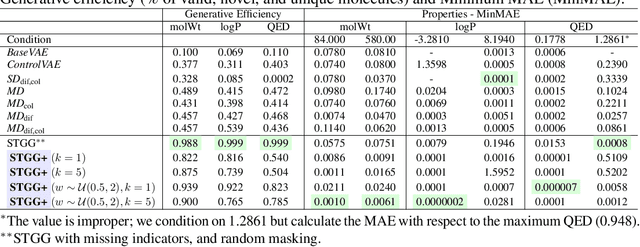
Abstract:Generating novel molecules is challenging, with most representations leading to generative models producing many invalid molecules. Spanning Tree-based Graph Generation (STGG) is a promising approach to ensure the generation of valid molecules, outperforming state-of-the-art SMILES and graph diffusion models for unconditional generation. In the real world, we want to be able to generate molecules conditional on one or multiple desired properties rather than unconditionally. Thus, in this work, we extend STGG to multi-property-conditional generation. Our approach, STGG+, incorporates a modern Transformer architecture, random masking of properties during training (enabling conditioning on any subset of properties and classifier-free guidance), an auxiliary property-prediction loss (allowing the model to self-criticize molecules and select the best ones), and other improvements. We show that STGG+ achieves state-of-the-art performance on in-distribution and out-of-distribution conditional generation, and reward maximization.
$μ$LO: Compute-Efficient Meta-Generalization of Learned Optimizers
May 31, 2024



Abstract:Learned optimizers (LOs) can significantly reduce the wall-clock training time of neural networks, substantially reducing training costs. However, they often suffer from poor meta-generalization, especially when training networks larger than those seen during meta-training. To address this, we use the recently proposed Maximal Update Parametrization ($\mu$P), which allows zero-shot generalization of optimizer hyperparameters from smaller to larger models. We extend $\mu$P theory to learned optimizers, treating the meta-training problem as finding the learned optimizer under $\mu$P. Our evaluation shows that LOs meta-trained with $\mu$P substantially improve meta-generalization as compared to LOs trained under standard parametrization (SP). Notably, when applied to large-width models, our best $\mu$LO, trained for 103 GPU-hours, matches or exceeds the performance of VeLO, the largest publicly available learned optimizer, meta-trained with 4000 TPU-months of compute. Moreover, $\mu$LOs demonstrate better generalization than their SP counterparts to deeper networks and to much longer training horizons (25 times longer) than those seen during meta-training.
LoGAH: Predicting 774-Million-Parameter Transformers using Graph HyperNetworks with 1/100 Parameters
May 25, 2024Abstract:A good initialization of deep learning models is essential since it can help them converge better and faster. However, pretraining large models is unaffordable for many researchers, which makes a desired prediction for initial parameters more necessary nowadays. Graph HyperNetworks (GHNs), one approach to predicting model parameters, have recently shown strong performance in initializing large vision models. Unfortunately, predicting parameters of very wide networks relies on copying small chunks of parameters multiple times and requires an extremely large number of parameters to support full prediction, which greatly hinders its adoption in practice. To address this limitation, we propose LoGAH (Low-rank GrAph Hypernetworks), a GHN with a low-rank parameter decoder that expands to significantly wider networks without requiring as excessive increase of parameters as in previous attempts. LoGAH allows us to predict the parameters of 774-million large neural networks in a memory-efficient manner. We show that vision and language models (i.e., ViT and GPT-2) initialized with LoGAH achieve better performance than those initialized randomly or using existing hypernetworks. Furthermore, we show promising transfer learning results w.r.t. training LoGAH on small datasets and using the predicted parameters to initialize for larger tasks. We provide the codes in https://github.com/Blackzxy/LoGAH .
Graph Neural Networks for Learning Equivariant Representations of Neural Networks
Mar 20, 2024



Abstract:Neural networks that process the parameters of other neural networks find applications in domains as diverse as classifying implicit neural representations, generating neural network weights, and predicting generalization errors. However, existing approaches either overlook the inherent permutation symmetry in the neural network or rely on intricate weight-sharing patterns to achieve equivariance, while ignoring the impact of the network architecture itself. In this work, we propose to represent neural networks as computational graphs of parameters, which allows us to harness powerful graph neural networks and transformers that preserve permutation symmetry. Consequently, our approach enables a single model to encode neural computational graphs with diverse architectures. We showcase the effectiveness of our method on a wide range of tasks, including classification and editing of implicit neural representations, predicting generalization performance, and learning to optimize, while consistently outperforming state-of-the-art methods. The source code is open-sourced at https://github.com/mkofinas/neural-graphs.
Can We Learn Communication-Efficient Optimizers?
Dec 02, 2023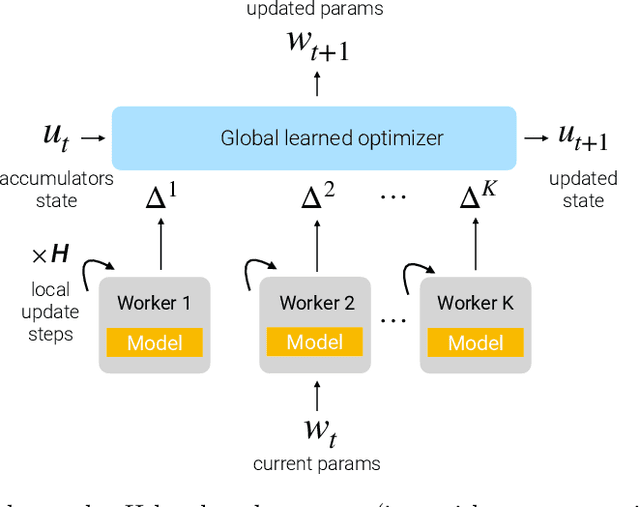

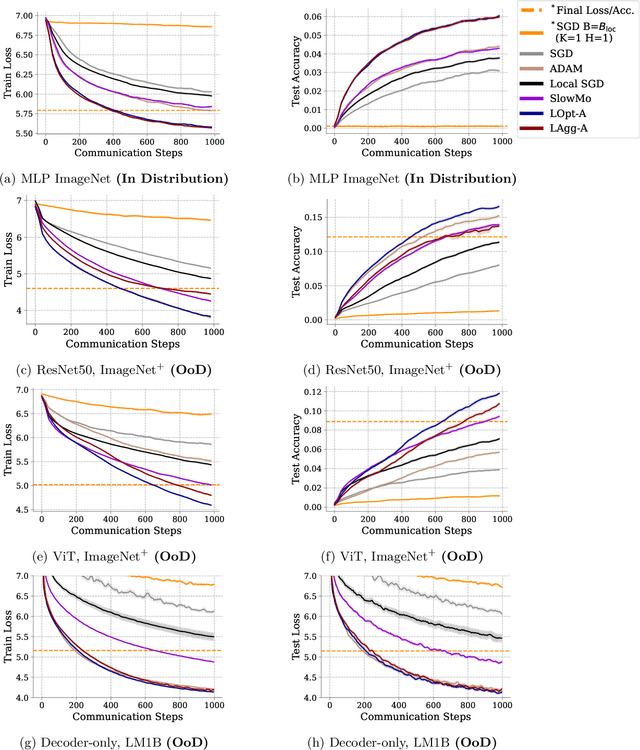

Abstract:Communication-efficient variants of SGD, specifically local SGD, have received a great deal of interest in recent years. These approaches compute multiple gradient steps locally, that is on each worker, before averaging model parameters, helping relieve the critical communication bottleneck in distributed deep learning training. Although many variants of these approaches have been proposed, they can sometimes lag behind state-of-the-art adaptive optimizers for deep learning. In this work, we investigate if the recent progress in the emerging area of learned optimizers can potentially close this gap while remaining communication-efficient. Specifically, we meta-learn how to perform global updates given an update from local SGD iterations. Our results demonstrate that learned optimizers can substantially outperform local SGD and its sophisticated variants while maintaining their communication efficiency. Learned optimizers can even generalize to unseen and much larger datasets and architectures, including ImageNet and ViTs, and to unseen modalities such as language modeling. We therefore demonstrate the potential of learned optimizers for improving communication-efficient distributed learning.
Can We Scale Transformers to Predict Parameters of Diverse ImageNet Models?
Mar 07, 2023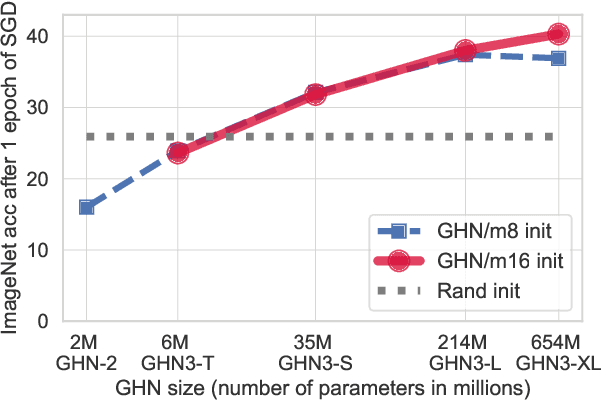
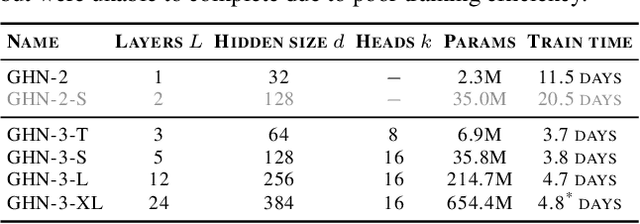
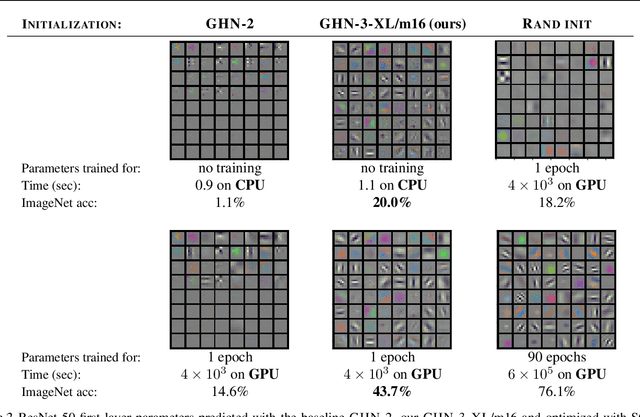
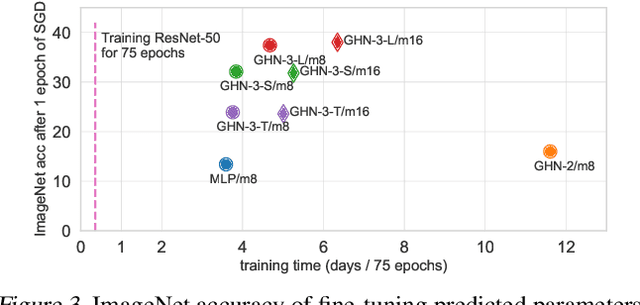
Abstract:Pretraining a neural network on a large dataset is becoming a cornerstone in machine learning that is within the reach of only a few communities with large-resources. We aim at an ambitious goal of democratizing pretraining. Towards that goal, we train and release a single neural network that can predict high quality ImageNet parameters of other neural networks. By using predicted parameters for initialization we are able to boost training of diverse ImageNet models available in PyTorch. When transferred to other datasets, models initialized with predicted parameters also converge faster and reach competitive final performance.
Model Zoos: A Dataset of Diverse Populations of Neural Network Models
Sep 29, 2022
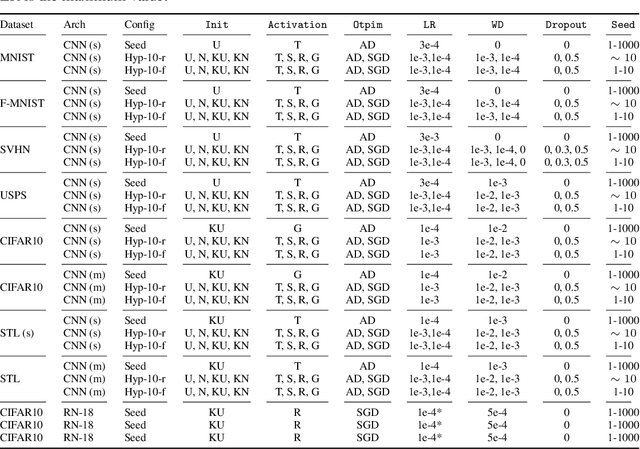

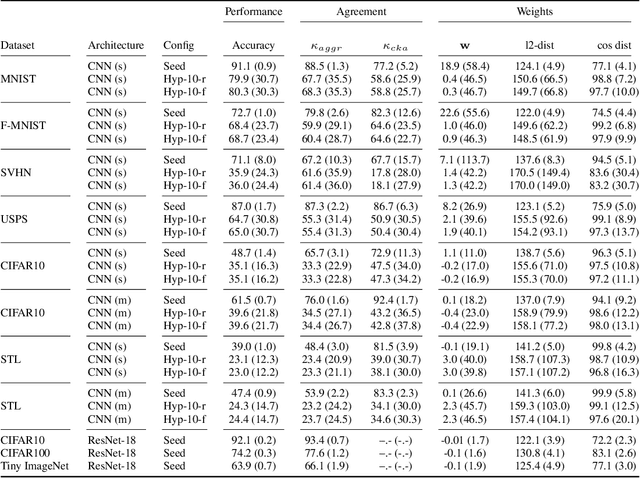
Abstract:In the last years, neural networks (NN) have evolved from laboratory environments to the state-of-the-art for many real-world problems. It was shown that NN models (i.e., their weights and biases) evolve on unique trajectories in weight space during training. Following, a population of such neural network models (referred to as model zoo) would form structures in weight space. We think that the geometry, curvature and smoothness of these structures contain information about the state of training and can reveal latent properties of individual models. With such model zoos, one could investigate novel approaches for (i) model analysis, (ii) discover unknown learning dynamics, (iii) learn rich representations of such populations, or (iv) exploit the model zoos for generative modelling of NN weights and biases. Unfortunately, the lack of standardized model zoos and available benchmarks significantly increases the friction for further research about populations of NNs. With this work, we publish a novel dataset of model zoos containing systematically generated and diverse populations of NN models for further research. In total the proposed model zoo dataset is based on eight image datasets, consists of 27 model zoos trained with varying hyperparameter combinations and includes 50'360 unique NN models as well as their sparsified twins, resulting in over 3'844'360 collected model states. Additionally, to the model zoo data we provide an in-depth analysis of the zoos and provide benchmarks for multiple downstream tasks. The dataset can be found at www.modelzoos.cc.
Hyper-Representations as Generative Models: Sampling Unseen Neural Network Weights
Sep 29, 2022
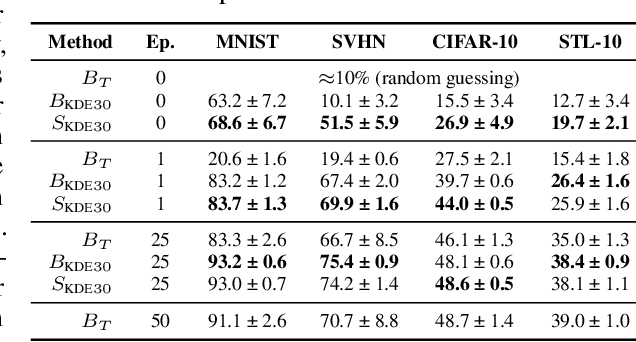


Abstract:Learning representations of neural network weights given a model zoo is an emerging and challenging area with many potential applications from model inspection, to neural architecture search or knowledge distillation. Recently, an autoencoder trained on a model zoo was able to learn a hyper-representation, which captures intrinsic and extrinsic properties of the models in the zoo. In this work, we extend hyper-representations for generative use to sample new model weights. We propose layer-wise loss normalization which we demonstrate is key to generate high-performing models and several sampling methods based on the topology of hyper-representations. The models generated using our methods are diverse, performant and capable to outperform strong baselines as evaluated on several downstream tasks: initialization, ensemble sampling and transfer learning. Our results indicate the potential of knowledge aggregation from model zoos to new models via hyper-representations thereby paving the avenue for novel research directions.
 Add to Chrome
Add to Chrome Add to Firefox
Add to Firefox Add to Edge
Add to Edge